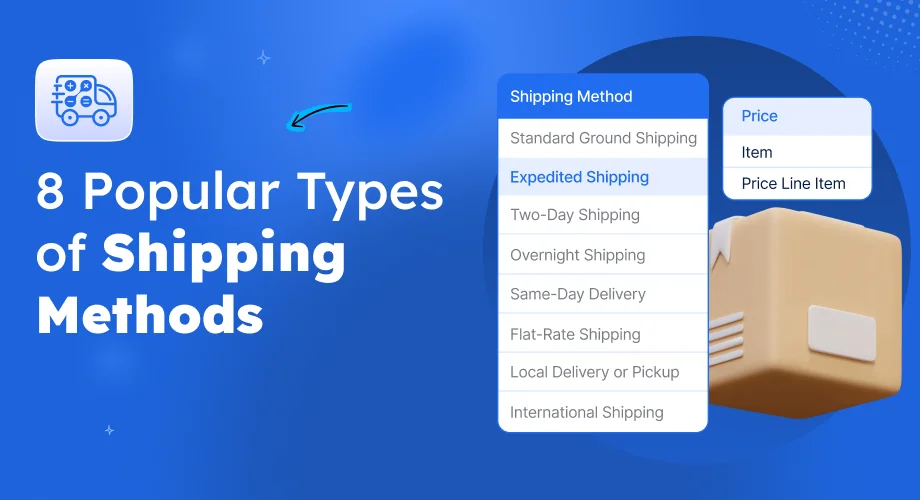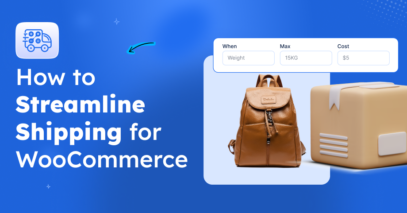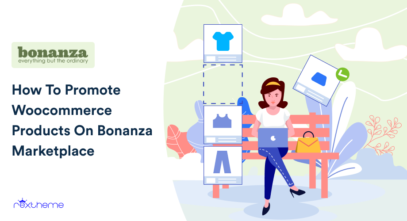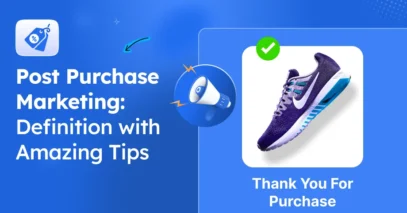After being closely involved in the ecommerce industry for years, one thing has become clear to me: shipping isn’t just about getting a package from point A to point B.
Customers today expect their orders to arrive fast, on time, and without any confusing costs. If your shipping feels complicated or expensive, even loyal buyers hesitate at checkout.
I’ve seen stores lose sales simply because the shipping options weren’t clear or flexible enough.
Not just me, 24% drop out of an online shopping session only because of the slower shipping methods.
That’s why I put together this guide.
I’m walking you through the 8 most popular types of shipping methods for 2025, how they work, when they make sense for your store, and practical tips for managing them efficiently in WooCommerce.
So, let’s go.
Why Shipping Methods Matter in Ecommerce
First of all, shipping is more than just getting a package from your warehouse to a customer’s doorstep. Every choice you make, from how fast you deliver to how much you charge, shapes the customer’s perception of your store.
When shipping feels confusing, slow, or expensive, it immediately affects how buyers feel about your brand.
Consider this: a customer adds products to their cart, but when they see high shipping costs or unclear delivery times, they hesitate. Even if they love your products, a poor shipping experience can make them abandon the cart and look for a competitor who offers clarity and flexibility.
On the other hand, effective shipping can do a lot for your business:
- Builds trust and transparency: When customers know exactly how much shipping will cost and when they’ll receive their order, they feel confident completing the purchase.
- Reduces cart drop-offs: Clear, fair shipping options remove one of the biggest barriers at checkout.
- Improves repeat purchase rate: A smooth delivery experience encourages customers to come back for future orders.
- Creates better brand perception: Reliable shipping makes your store feel professional and customer-focused, increasing overall satisfaction.
Every store’s ideal shipping setup is different. It depends on your audience, where your products ship to, and the types of products you sell.
That’s why understanding the different shipping methods and when to use them is key, and I’ll break down each option in detail next.
8 Popular Types of Shipping Methods You Must Consider
Every shipping method has its own strengths, costs, and best use cases. The key is to pick the right one depending on your products, order type, and how quickly your customers expect delivery. Many stores combine methods to give buyers flexibility and improve the checkout experience.
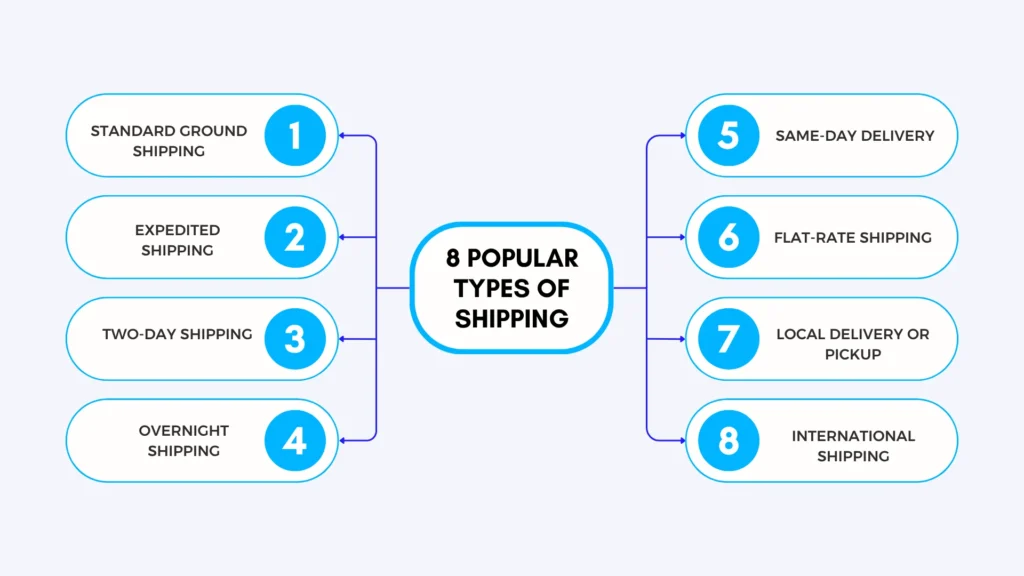
Let’s break down the most popular options in 2025.
1. Standard Ground Shipping
Standard ground shipping is your go-to for domestic orders that aren’t urgent. It usually takes a few business days, and it’s reliable for most items that aren’t time-sensitive.
Suppose you sell kitchen appliances like blenders. A customer orders a blender on Monday and doesn’t need it immediately. Standard ground shipping works well here because it’s cost-effective and predictable.
Pros:
- Affordable for both you and your customer
- Works for most domestic products
- Predictable delivery times in most areas
Cons:
- Slower than faster options like expedited or overnight
- Not suitable for items that need to arrive quickly
2. Expedited Shipping
Expedited shipping is the faster alternative to standard ground. Packages usually arrive within 1–3 business days, making it perfect for customers who need their orders quickly.
Imagine you sell electronics like Bluetooth headphones. A customer wants them before the weekend to gift a friend. Expedited shipping ensures the order arrives on time without waiting for standard delivery.
Pros:
- Faster delivery keeps customers happy
- Ideal for high-value or urgent orders
- Can reduce abandoned carts when buyers need speed
Cons:
- Costs more than standard shipping
- Requires careful handling to prevent damage during faster transport
3. Two-Day Shipping
Two-day shipping has become almost expected for online shoppers, thanks in large part to services like Amazon Prime. It’s faster than standard ground but not as urgent as overnight, making it a sweet spot for many ecommerce stores.
Let’s say you sell skincare kits. A customer orders a set of face masks on Wednesday and expects it by Friday for the weekend. Two-day shipping meets that expectation without charging as much as overnight delivery.
Pros:
- Gives customers a sense of urgency without high cost
- Works well for a wide range of products
- Reduces the risk of cart abandonment for shoppers who want faster delivery
Cons:
- Slightly more expensive than standard ground
- Requires careful inventory and fulfillment planning to guarantee two-day delivery
4. Overnight Shipping
Overnight shipping is for when speed really matters. Orders placed today arrive the next day, which is perfect for last-minute gifts or urgent items.
For instance, you sell luxury watches. A customer orders one late in the evening as a birthday gift for tomorrow. Overnight shipping ensures it reaches them on time, which makes the customer happy and keeps your store’s reputation solid.
Pros:
- Fastest delivery option for domestic orders
- Perfect for urgent, high-value, or perishable items
- Boosts customer satisfaction when speed matters
Cons:
- High cost compared to other methods
- Not practical for all products, especially bulky or heavy items
5. Same-Day Delivery
Same-day delivery is growing in demand, especially for urban and local ecommerce stores. It’s ideal when customers want their orders within hours rather than days.
Imagine you run a local bakery that sells custom cupcakes online. A customer places an order in the morning for a party happening in the afternoon. Same-day delivery ensures the cupcakes arrive fresh and on time, keeping the customer satisfied.
Pros:
- Extremely fast, meeting immediate customer needs
- Builds trust with local buyers who expect convenience
- Can increase order frequency for nearby customers
Cons:
- Usually limited to certain locations
- Can be expensive due to quick logistics and handling
- Requires careful scheduling and fulfillment coordination
6. Flat-Rate Shipping
Flat-rate shipping is simple: you charge a fixed shipping fee regardless of order weight or distance. This makes it predictable for both you and your customers.
Let’s say you sell t-shirts in your online store. Whether a customer buys one shirt or three, they pay a flat $5 shipping fee. This is easy for buyers to understand and reduces hesitation at checkout.
Pros:
- Easy to communicate to customers, avoiding confusion
- Predictable cost for buyers, which can improve checkout completion
- Works well for products with consistent weight or size
Cons:
- May result in overcharging small, light orders or undercharging heavy ones
- Less flexible for international or variable-sized shipments
- Can reduce profit margin on larger orders if not calculated carefully
7. Local Delivery or Pickup
Local delivery and in-store pickup are ideal for businesses that have a physical location or operate in a specific city or region. This method saves shipping costs and gives customers flexibility in how they receive their orders.
Imagine you run a small home decor store with a local showroom. A customer orders a set of candles online but prefers to pick them up the same day. Offering local pickup or delivery lets them get the products quickly without paying extra for standard shipping.
Pros:
- Reduces shipping costs for both the store and the customer
- Builds a stronger connection with local buyers
- Flexible for customers who want to choose when and how to get their order
Cons:
- Only works for customers within a certain distance
- Requires staff or logistics to manage pickups and deliveries
- Not suitable for nationwide or global orders
8. International Shipping
International shipping allows your store to reach customers around the world, expanding your market. It comes with extra considerations, like customs, taxes, and longer delivery times.
For example, you sell handmade jewelry and receive an order from a customer in Europe. International shipping ensures the package arrives safely while giving the buyer a clear idea of delivery times and any additional customs fees.
Pros:
- Opens your store to a global audience
- Increases sales opportunities beyond domestic markets
- Can build your brand presence internationally
Cons:
- Higher shipping costs and longer delivery times
- Requires clear communication about customs, duties, and taxes
- Complex logistics compared to domestic shipping
How to Choose the Right Shipping Method for Your Store
Now that you know the most popular shipping methods in 2025, the next step is figuring out which ones actually make sense for your store.
There isn’t a single “best” option—what works for one business might not work for another. Your choice depends on the products you sell, who your customers are, and what kind of delivery experience you want to promise.
Here are the main things to think about when deciding on your shipping setup:
- Product weight and dimensions: Heavy or bulky items often cost more to ship. For example, if you sell large furniture pieces, standard ground or freight shipping might make more sense than overnight delivery. Small, lightweight items like phone cases can easily use flat-rate or expedited shipping without eating into your margins.
- Delivery location and customer expectations: Where your customers are matters. Urban shoppers may expect same-day or two-day options, while rural or international buyers understand longer delivery times. Matching your shipping method to their expectations keeps them satisfied and reduces abandoned carts.
- Average order value: If most of your orders are small, flat-rate shipping might be simpler. For high-value orders, you can offer expedited or overnight options to give customers extra confidence that their purchase will arrive quickly and safely.
- Shipping cost structure: Consider how much you’re willing to pass on to customers versus absorbing yourself. Free shipping may increase conversions, but it can hurt profit if not calculated correctly. For some products, a price-based or weight-based fee makes more sense.
- Returns and tracking reliability: Some shipping methods offer better tracking and easier returns than others. If you sell fragile items or electronics, you’ll want a carrier that provides detailed tracking updates and reliable handling.
Choosing the right combination of shipping methods comes down to balancing cost, speed, and customer expectations. When you think about your products, who is buying them, and how quickly they need them, the right methods become clear.
Next, I will show some practical ways to set up these shipping options efficiently in WooCommerce, so your customers always know what to expect.
How to Apply These Shipping Methods in WooCommerce
Now that you know which shipping methods work best for your store, the next step is making them work inside WooCommerce.
The goal is to give buyers clear, fair, and flexible options, so they feel confident at checkout and that’s exactly where Advanced Shipping for WooCommerce can help.
i. Set Custom Rules for Shipping Rates
With Advanced Shipping, you can create custom rules for each method. For example:
- Free shipping on small items like phone accessories
- Higher rates for heavier products like appliances
- Different rates for wholesale and retail customers

This makes sure every buyer sees shipping options that fit their order, without confusion.
ii. Offer Free or Discounted Shipping Without Hurting Margins
Advanced Shipping lets you set price-based or bulk-order rules. For example, a customer buying three or more items can get a discounted shipping rate. You can set it up so these incentives don’t cut into your profit, encouraging bigger orders while keeping your margins safe.

iii. Create Location-Based Shipping Like Amazon
You can also tailor shipping based on location or urgency. Urban buyers might see faster options, while distant customers follow standard delivery. Advanced Shipping makes it easy to define regions, ZIP codes, or priority rules, giving buyers a flexible, personalized experience.

iv. Manage Heavy or Bulky Item Shipping Easily
Shipping large items can be tricky, but Advanced Shipping lets you set rules by weight or size. That way, furniture, appliances, or other bulky items are handled correctly, with shipping costs that reflect the effort and expense, protecting your profits.
These smart rules make shipping fair, predictable, and personalized. Buyers see options that actually match their order, making them feel valued and confident at checkout.
Laatste gedachten
Shipping isn’t just a backend task; it’s part of the sales experience. How you handle delivery can influence whether a customer completes their purchase, comes back again, or leaves frustrated.
Take a moment to audit your current setup. Look at the shipping options you offer, the rates, and how flexible they are. Then test 2–3 methods that fit your audience’s needs, whether that’s fast local delivery, predictable flat-rate shipping, or international options with clear costs.
Tools like Advanced Shipping for WooCommerce make this easier. You can set rules for rates, regions, product types, and bulk orders, turning shipping from a simple cost into a feature that adds value and boosts conversions.
FAQs
1. How many types of shipping methods are there?
There are multiple types of shipping methods used in ecommerce, each designed to meet different delivery needs. Common shipping types include standard, expedited, overnight, and same-day delivery. The number of options depends on your store size and product variety. Choosing the right mix helps improve customer satisfaction.
2. What is a shipping method?
A shipping method is the way a product moves from your store to the customer. In ecommerce, it defines the speed, cost, and service type. Shipping method examples include standard ground, two-day shipping, and international shipping. Picking the right method makes the buying experience smooth for your customers.
3. What’s the best shipping method?
There isn’t a single “best” option—your ideal shipping method depends on your products and customer needs. Combining different shipping types like standard for most orders and expedited for urgent ones, works well. Observing what your customers prefer helps you pick the right options. The goal is to keep them happy and coming back.
4. What’s the fastest type of shipping?
The fastest shipping type is typically same-day or overnight delivery. These are popular in ecommerce for urgent or high-value orders. Other types of shipping methods like two-day shipping offer a balance of speed and cost. Offering fast options improves customer satisfaction and trust in your store.
5. What is a shipping strategy?
A shipping strategy is your plan for offering and managing shipping methods in ecommerce. It defines which shipping types you provide, how rates are calculated, and which options suit different customer needs. A smart strategy balances cost, speed, and reliability. This ensures buyers feel confident at checkout and encourages repeat purchases.
